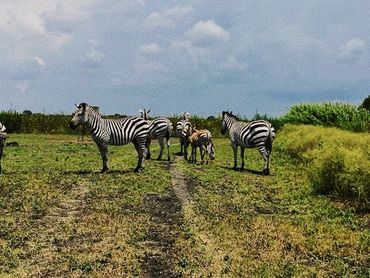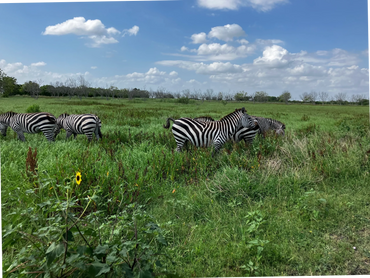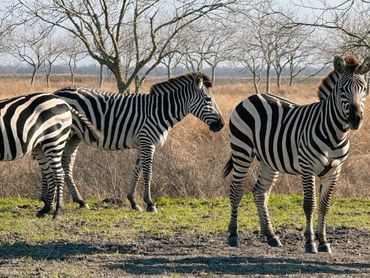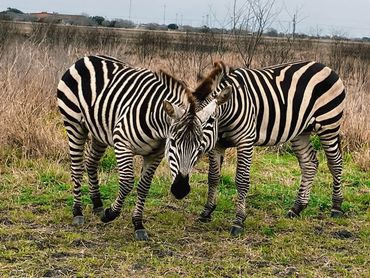
Our Zebra Sanctuary
Rescues, heals, and protects zebras abandoned, neglected, exploited, or displaced across the U.S. Providing a safe, natural, permanent refuge, free from harm. More than a home, it’s a living reminder of God’s creativity and grace: stripes tell stories of restoration, hearts are lifted, hope is renewed, and faith grows
Our mission: care for creation, inspire compassion, and point every heart to the One who makes all things new.
Animals kill for need. Humans kill for greed.

Zebra Stripes Could Be Pest Control
It can be tricky to pin down just why an animal’s coat looks a certain way, and scientists have a few ideas about why zebras evolved to have their trademark black and white stripes — they might act as thermoregulation, or as a unique, confusion-based kind of camouflage, to name just a couple of examples. But one of the more promising, consistent theories — although scientists are still ultimately divided — is that the striped pattern keeps dangerous flies away.
After finding that zebra stripes are more pronounced in areas of Africa with more horseflies and tsetse flies (which can transmit deadly diseases among equines), an evolutionary biologist assembled a team for a new experiment. They observed horses, some dressed up in zebra-striped coats, next to some especially tame zebras, and found that while flies hovered around all of them, they rarely landed on zebras or the striped horses compared to the horses without coats. When flies would approach zebra-striped surfaces, they would behave as if they couldn’t find a good spot to land.

🐾 It’s a Girl! 🦓
We’re thrilled to announce the arrival of the first baby zebra born at our sanctuary!
Meet our newest (and stripiest) addition—a healthy foal born right here in Bloomington, Texas.
Thank you to everyone who supports our mission to protect and care for these incredible animals. Stay tuned for more updates as he finds his footing! 🍼🌿










Zebra's Interesting Facts






Why Every Zebra’s Stripes Are One of a Kind
Why Every Zebra’s Stripes Are One of a Kind
Why Every Zebra’s Stripes Are One of a Kind

Did you know no two zebras have the same stripe pattern? Just like human fingerprints, each zebra’s stripes are completely unique. Scientists believe this helps zebras recognize each other and may even confuse predators. At our Texas sanctuary, we celebrate these beautiful differences — every zebra we rescue has its own "barcode of life!"
Why Texas Is a Perfect Home for Zebras
Why Every Zebra’s Stripes Are One of a Kind
Why Every Zebra’s Stripes Are One of a Kind

With its wide-open spaces, sunny weather, and warm temperatures, Texas is a natural fit for zebras. Our sanctuary gives these amazing animals the land, freedom, and safety they need to thrive — while also giving Texans a rare opportunity to see zebras up close in a truly natural environment.
A Kick You Don't Want to Mess With
Why Every Zebra’s Stripes Are One of a Kind
From Africa to Texas — Saving Zebras in a Changing World

Zebras might look gentle, but they are fierce defenders! A zebra’s kick is powerful enough to seriously injure — or even kill — a lion. At our sanctuary, we give our zebras plenty of space to feel safe and relaxed, respecting their natural instincts while giving them room to roam.
From Africa to Texas — Saving Zebras in a Changing World
From Africa to Texas — Saving Zebras in a Changing World
From Africa to Texas — Saving Zebras in a Changing World

Across Africa, zebras are losing their natural homes to farming and development. Here in Texas, we’re giving rescued zebras a second chance. Our sanctuary provides a safe haven where these incredible animals can live out their lives in peace — and where people can learn why protecting them matters.
How We Rescue and Care for Zebras
From Africa to Texas — Saving Zebras in a Changing World
How We Rescue and Care for Zebras

Not every zebra born in captivity is lucky. Some end up in unsafe situations without proper care. That’s where we step in. Our sanctuary takes in zebras that need safe, permanent homes — providing expert veterinary care, large open pastures, and a life free from harm or exploitation.
The Power of the Herd
From Africa to Texas — Saving Zebras in a Changing World
How We Rescue and Care for Zebras

Zebras are deeply social animals that depend on their herds for survival. In the wild, they travel, graze, and protect each other as a team. That’s why at our Texas sanctuary, we allow rescued zebras to form their own social groups naturally, creating bonds that can last a lifetime.
About Zebras

Each Zebra’s Stripes Are Unique, Like a Fingerprint
No two zebras have the same pattern. Scientists believe stripes help zebras recognize each other individually.
Zebras Communicate Through Facial Expressions and Sounds
They bray, snort, and whinny, and even use their ears and tails to signal feelings — like anger, fear, or affection.
Zebras Are True Nomads
Wild zebras migrate across hundreds of miles each year in search of food and water — the longest land migration of any African mammal.
Zebras Are Born Ready
Newborn zebras can stand within six minutes of birth and start running within an hour!
The Name "Zebra" Comes from a Portuguese Word
The word zebra likely comes from the Portuguese zevra, meaning "wild ass."
Really Strong Reasons for a Zebra Sanctuary in Texas
Conservation and Protection
Conservation and Protection
Conservation and Protection
Zebras, especially species like Grevy’s zebras, are endangered due to habitat loss, poaching, and climate change. Sanctuaries can actively support global conservation efforts by providing safe homes for surplus, surrendered, or rescued zebras.
Rescue and Rehabilitation
Conservation and Protection
Conservation and Protection
Many zebras in the U.S. are privately owned without proper care or understanding of their needs. Our sanctuary can provide a humane alternative for surrendered or confiscated animals.
Education and Awareness
Conservation and Protection
Education and Awareness
Very few people in Texas — or the U.S. — have direct, respectful educational opportunities to learn about zebras. We provide those opportunities.
Veterinary and Wildlife Management Expertise
Veterinary and Wildlife Management Expertise
Veterinary and Wildlife Management Expertise
Texas already has a strong exotic animal veterinary community due to its large ranch and private wildlife industries. Our sanctuary has access to top-level care.
Providing Lifelong Homes
Veterinary and Wildlife Management Expertise
Veterinary and Wildlife Management Expertise
Zebras live 20–30 years in captivity. Our Sanctuary offers a stable, lifetime home versus the instability often experienced by exotic animals in private hands.
Preserving Ethical Standards
Veterinary and Wildlife Management Expertise
Preserving Ethical Standards
Many so-called "exotic animal attractions" fail to meet humane standards. We have established a gold standard for how zebras should be cared for — focusing on respect, space, and dignity.
Why Zebras Don’t Belong in Circuses or Captivity
At Keep Bloomington Beautiful, we are committed to protecting every aspect of the natural world—including the dignity and well-being of the animals who share it with us. This commitment is why we operate a non-exhibit zebra sanctuary and advocate for an end to the use of wild animals, including zebras, in captivity and entertainment.
The Reality of Zebras in Circuses
Zebras are wild, herd animals—not performers. They are not meant to be confined, trained, or displayed for human amusement. Sadly, the entertainment industry has exploited zebras for decades.
In many traveling circuses, zebras are kept in “beast wagons”—small, mobile cages that severely restrict their ability to move, graze, or behave naturally.
- Zebras and other circus animals spend up to 96% of their lives in cages or chains.
- During the off-season, many are housed in tiny traveling crates, leading to extreme psychological stress and physical health problems.
- Life on the road includes stressful transport, harsh training methods, and constant exposure to loud noise, flashing lights, and crowds, causing anxiety and abnormal behaviors.
- Prolonged confinement and forced performances frequently result in hoof problems, arthritis, and chronic pain from walking or standing on hard, unnatural surfaces.
The United States Is Falling Behind
More than 35 countries, including the United Kingdom, Austria, Greece, Argentina and Peru, have banned or heavily restricted the use of wild animals in circuses. These nations recognize that such practices are inhumane and outdated.
In contrast, the United States continues to allow wild animals in circuses in many jurisdictions. Some cities, such as Los Angeles and New York City, have enacted local bans, but federal laws remain minimal and inconsistently enforced.
According to Animal Defenders International, more than 300 wild and exotic animals are still being used in U.S. circuses today. Many of the major circuses in the country have been cited for repeated violations of the Animal Welfare Act, involving serious neglect and abuse.
Zebras Deserve Better
Zebras are not meant to live in confinement. They are social animals who thrive in open spaces and natural herds. In captivity, they are denied freedom, companionship, and the ability to express natural behaviors. Instead, they are reduced to involuntary performers in unnatural and stressful conditions.
At our sanctuary, zebras are never used for exhibition or profit. They roam freely in a safe, spacious, and peaceful environment, protected from the stresses of public display. We do not offer tours, ensuring that the animals are left undisturbed to live as closely to their natural behavior as possible.
How You Can Help?
You don’t have to remain silent. Here are ways you can make a difference:
- Avoid circuses that use wild animals. Support cruelty-free alternatives that highlight human talent.
- Educate your community about the suffering animals endure in entertainment.
- Support legitimate sanctuaries that prioritize animal welfare, not profit or publicity.
- Contact lawmakers to demand stronger protections and nationwide bans on the use of wild animals in circuses.
Our Commitment
Keep Bloomington Beautiful is dedicated to raising awareness about the cruelty and long-term harm inflicted on zebras and other animals in circuses and captive environments. We believe there is no place for animal exploitation in a modern, compassionate society.
Our Mission at Keep Bloomington Beautiful
At our zebra sanctuary:
- Zebras are not on display.
- They live freely, safely, and undisturbed—as nature intended.
- We stand against the use of wild animals in entertainment.
Let’s work together to ensure wild animals stay wild—and are treated with the freedom and dignity they deserve.
Warning: The following photos contain graphic images of zebra abuse in traveling circuses and other captive environments. Viewer discretion is advised


















This website uses cookies.
We use cookies to analyze website traffic and optimize your website experience. By accepting our use of cookies, your data will be aggregated with all other user data.
